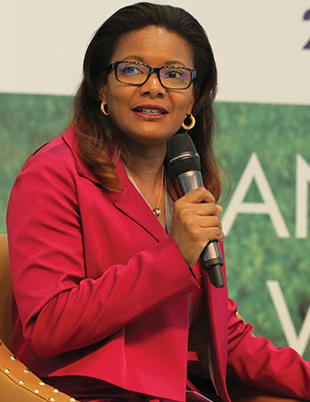African Development Bank is venturing into green bonds and euro issuance as part of its 10-year strategy to boost developing economies and intra-continental trade. David Wigan reports.
African Development Bank (AfDB) plays a key role in promoting growth, industrialisation and integration, supported by sovereign shareholders around the world. The bank has a 10-year strategy to deliver its so-called ‘High 5s’, its development priorities aimed at helping African countries grow faster and align with the UN Sustainable Development Goals. However, with inward investment flatlining over recent years, AfDB is seeing unprecedented demand for its services.
African aggregate economic growth was about 3.6% in 2017, compared with 2.2% in 2016, but with wide variations between countries. The continent’s largest economies, Nigeria, South Africa and Egypt, performed well, while output in the Republic of the Congo and Equatorial Guinea contracted sharply and had a knock-on effect on the central African region. Huge structural challenges remain: at least 50% of Africa’s youth is unemployed or underemployed, and many governments are hampered by weak current account positions.
“We are serving a larger number of countries and have seen rising demand for development assistance,” says AfDB director of treasury Hassatou N’Sele. “We play a countercyclical role, and the commodity price slump over the recent period has created additional challenges and has meant it has been important to expand our operations.”
Ambitious goals
The High 5s comprise targets to power, feed, industrialise, integrate and improve quality of life in Africa. By 2025, AfDB aims to massively expand the continent’s electrical grid, lift 130 million people out of extreme poverty and increase industry’s contribution to gross domestic product by 130%. A key ambition is to increase intra-continental trade, which is the lowest globally at 15%, compared with 61% in Asia and 60% in the EU. Through its loans and partnerships, AfDB hopes to create 25 million jobs.
In 2017, the AAA rated development bank made $8.7bn of loans, slightly less than the $10.8bn the previous year but part of a long-term upward trend. AfDB’s total assets were $46.4bn in 2017, the highest on record, with loans outstanding of $25bn. The bank was carrying $33bn of debt at the end of 2017, compared with $19bn in 2014.
A key element of the bank’s increased lending ability has been efforts to optimise its balance sheet: it has implemented several private sector credit initiatives, syndication programmes and the partial sell-down of loans to external investors. The result is an increase in the average risk weighting of its portfolio to BB+ in 2017, reflecting a sovereign loan book dominated by low-risk exposures and a prudent approach to corporate lending. “Our financing activities are extensive and growing, but with that in mind we have also had to rethink our funding programme,” says Ms N’Sele.
Traditionally AfDB’s financing has been dollar-driven, but the bank has diversified in recent years. It has sold multi-currency green bonds and gradually built out a euro curve, issuing an inaugural 10-year benchmark in October 2016 and a seven-year in early 2017. The euro-denominated bonds attracted 49 new investors to the bank.
Liquid issuer
Over the past two years, AfDB has sought to reposition itself as a more liquid issuer at specific points on the yield curve. In March 2017, it sold $2.5bn of three-year bonds and followed that up in October with a $2bn five-year benchmark, which printed at 12 basis points outside mid-swaps. The latest iteration of the plan was a three-year dollar bond.
Our financing activities are extensive and growing, but with that in mind we have also had to rethink our funding programme
“We had approval in December for a funding programme of about $8bn this year, and we then monitored the market for an opportunity to do a large benchmark,” says Ms N’Sele. “We had daily discussions with banks in respect of market conditions and we were keeping an eye on swap quotes.”
AfDB is prohibited from taking foreign exchange risk, so it must match its assets and liabilities by currency, and align the currency composition of its net assets with the International Monetary Fund’s Special Drawing Rights basket. It achieves that through its derivatives strategy, which is an important factor in its choice of banking partners on specific deals.
As swap spreads widened in early March 2018, AfDB’s treasury team saw a window. On March 13 it announced a mandate to sell a $2bn three-year bond, its first public deal of the year, led by Bank of America Merrill Lynch, Barclays, BMO, Nomura and TD.
Initial price thoughts were set at mid-swaps plus one basis point (bp) area, and the deal saw a strong reception from the outset with indications of interest reaching $2bn by the end of the US day. Books officially opened the following European morning with price guidance of mid-swaps flat. Demand rose to $3bn within an hour and banks tightened guidance to mid-swaps minus 1bp. The transaction was priced in the London afternoon at that spread, representing a re-offer yield of 2.661% or 26.35 basis points over Treasuries.
A record order book and first print inside mid-swaps: excellent news for the AfDB and its many stakeholders.



